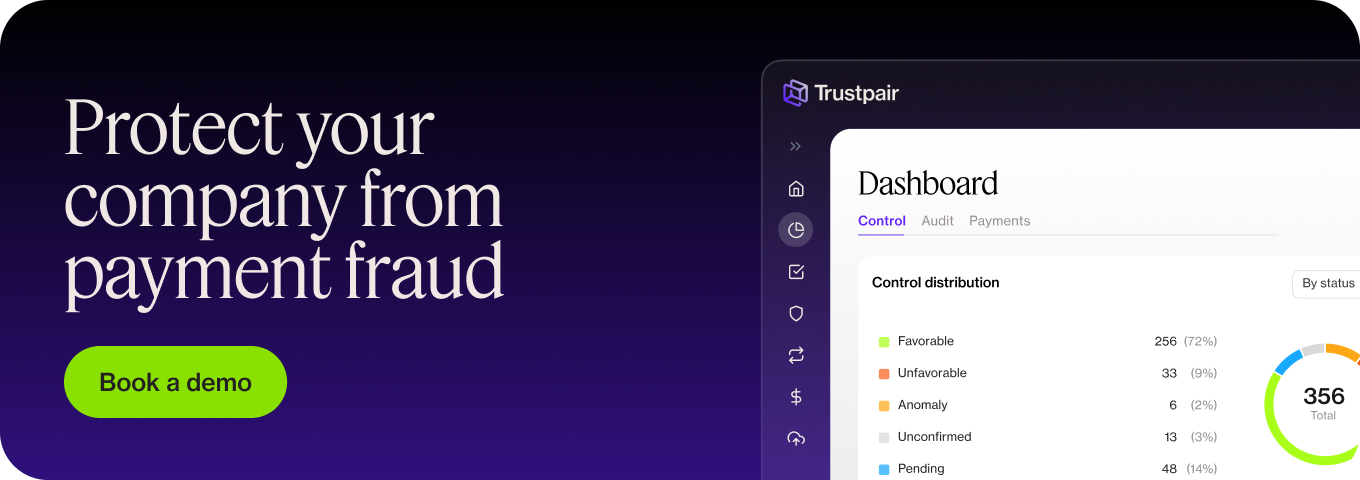Internal fraud is a risk all organizations face. In our recent article about corporate fraud, we discussed some of the main motivators, scams, and scandals relating to internal fraud. Internal fraud can take down entire companies, sectors, or even economies. On top of that, the reputational cost of internal fraud can be enough to destroy a business. As with most things, prevention is better than the cure. Make sure you know the risks and warning signs and that company processes are one step ahead of employee fraud. Read on to protect your business!
To avoid the financial loss of internal fraud, use a fraud prevention platform like Trustpair. We block fraudulent payments by ensuring ongoing account validation. Request a demo to learn more!
Internal fraud risks and types
Internal fraud, often also known as occupational fraud, can be as simple as an employee stealing stationery or fraudulently claiming expenses. Or it can be as complex as a group of employees complicit in manipulating company accounts to hide losses or siphoning off money to their own accounts.
In between we have everything else: misuse of company assets, falsifying invoices, embezzling money, committing accounting fraud or using privileged information. If you can think of a way to leverage money, assets, or information for personal gain from an employer then someone has probably already tried it.
- Frauds may start small but increase when it goes undetected. Some people will be motivated by greed, some by fear.
- Employees may feel they ‘deserve’ more money or think the company ‘won’t notice’ a comparatively small amount of cash, or one of many assets.
- Others may be motivated by the fear of failure and will make up sales or hide losses to avoid losing their job or missing a promotion. They may have bills to pay, a divorce looming or an addiction and see no other way forward.
- Employees may be facing outside pressure to commit a criminal act against their company through corruption or bribery.
Internal fraud occurs when an employee sees an opportunity and thinks theft will remain undetected. This is often because company culture or processes effectively allow it.
Preventing and detecting internal fraud
The simplest way to prevent internal fraud is to make it extremely difficult from the outset and remove the opportunity. A popular fraud theory named the Fraud Triangle theory explains that 3 components need to be present for an employee to commit fraud. These components are opportunity, rationalization, and pressure. Remove one and fraud won’t happen.
Having a fraud detection plan and making this known to employees will act as a deterrent and help any anomalies to be detected early. This can save time, money and potentially a company’s reputation too. According to the Association of Certified Fraud Examiners (ACFE), the average amount of time a fraud goes undetected is 14 months.
- Know your employees
Make sure you screen new employees. Sign up to an internal fraud database: people who have defrauded one company will often do the same thing at another. Keep an open dialogue with all employees: financial problems, personal issues or feeling bitter towards an organisation are all warning signs that they could be at risk.
- Use internal controls
Make sure processes are in place to prevent anyone with access to funds acting unilaterally. Have a series of checks and balances and segregate duties so that there is a chain of employees effectively confirming that everything is the same as it moves along the line. This can highlight discrepancies in accounting or reporting, for example. Make sure everything is documented properly but within a climate of transparency rather than distrust. Internal control and audit are useful to make sure an organization’s activities are led with transparency and compliance to internal processes.
- Make sure company culture is in line
It is vital that organisations operate a culture of openness and ethical behaviour. It should be made clear that fraud will not be tolerated and that there are processes in place to deter and detect it. Ensure that all employees receive regular training on how to avoid and spot fraud.
Create a culture where employees can report any concerns they may have, anonymously and without recourse. The ACFE found that 43% of frauds were detected following a tip-off and, of those, half were from employees.
Employees should also feel able to go to management with personal issues. These may have an impact on their susceptibility to committing fraud. Overly-aggressive targets or unreasonable expectations should be avoided.
Deal with issues as soon as they appear and do not make any allowances or exceptions.
- Use software that will help prevent, monitor, and detect occupational fraud
The right software will add an extra layer of security. Trustpair’s system runs an automatic check of payment files, detects suspicious behaviour and makes third-party data more reliable over time. Our bank account validation tool increases security, particularly for procure-to-pay systems and reduces costs.
We can help you reduce your company’s risk of internal fraud. Contact us to find out more and request a demo today.
Key Takeaways:
- Internal fraud is committed by one or more employees and can be extremely costly. It includes embezzlement, theft, money laundering as well as invoice or accounting fraud.
- Prevention and early detection are key to blocking the significant financial effects that can occur after insider fraud. Effective prevention measures include awareness training, internal controls, and anti-fraud solutions.
- Trustpair will you give extra security and peace of mind. Our services include automated data monitoring, extensive reporting, and customer support.


